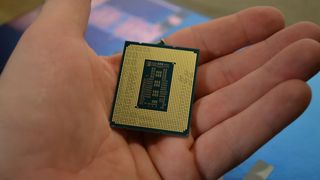Intel’s issues of high-end thirteenth and 14th-gen CPUs crashing and affected by instability basically might not be over with the patch Crew Blue has inbound for mid-August, a minimum of if some recent leaked data is anything else to head by way of.
You most likely gained’t have neglected the newest building from Intel wherein previous this week, the corporate pinned instability gremlins on a topic with ‘increased running voltage’ with its more moderen Core i9 (and possibly lower-tier) processors – set to be fastened by way of the discussed microcode replace due subsequent month.
Then again, this patch might not be your entire resolution for the CPU crashing blues, as a result of if leaked data from Igor’s Lab is true – upload your individual seasoning, naturally – Intel continues to be having a look into different root reasons for the instability in proof right here.
The main points Igor’s Lab bought – from an inner conversation inside Intel, it seems that – declare that: “Intel observes an important building up to the minimal running voltage (Vmin) throughout a couple of cores on returned affected processors from consumers.
“This building up is the same in end result to portions subjected to increased voltage and temperature stipulations for reliability trying out.”
The notes pass on to mention that components inflicting mentioned Vmin building up come with increased voltages (which the patch addresses), in addition to excessive clock speeds and increased temperatures (the previous will power the latter, in fact). And that even if the CPU is idling, and fairly cool, spikes of job may cause in short increased voltage, and at a “sufficiently excessive voltage, those short-duration occasions can gather over the years, contributing to the rise in Vmin.”
The realization is: “Intel research signifies a want to scale back the utmost voltage asked by way of the processor as a way to scale back or do away with accrued publicity to voltages which might lead to an building up to Vmin.
“Whilst Intel has showed increased voltages affect the rise in Vmin, investigation continues as a way to totally perceive the basis purpose and cope with different possible facets of this factor.”

Research: A ready recreation
As Igor’s Lab observes, there’s not anything ‘reprehensible’ about those (purported) inner notes from Intel, they usually underline one thing we reported in our earlier article in this matter. In a separate remark on Reddit, Intel seen that the increased running voltage factor was once a ‘key component’ within the crashing woes customers are experiencing, which means that there are different components. As we discussed in our earlier dialogue, those may well be components no longer but pinned down (versus previous recommendation and patching, akin to Intel’s tweaking to Enhanced Thermal Pace Spice up).
Briefly, there might nonetheless be gremlins lurking within the works, and the August microcode replace – which is about to restrict the max voltage the CPU can request (referred to as the VID) to one.55V – might not be a cure-all for the crashing problems.
As Intel additional states within the leaked notes: “Whilst this microcode replace addresses the increased voltage facet of this factor, additional research is needed to know if this proposed mitigation addresses all situations.”
Necessarily, if those musings from Intel personnel are certainly right kind, the company isn’t totally certain that this will likely clear up the whole thing. Certainly, the leaked subject matter additional states that: “This microcode replace, as soon as validated and launched, won’t cope with current programs within the box with instability signs.”
May that be as a result of they’re too a long way long gone in relation to experiencing the issue for months now, and degradation problems therein? That’s what numerous worries are concerned about, from what we’ve noticed, and the imaginable long run results of this drawback in the long run.
Intel reputedly advises that: “Programs which proceed to show off signs related to this factor [after the microcode update] must have the processor returned to Intel for RMA.”
As Intel has mentioned prior to, it’s ‘dedicated to creating this proper’ with consumers in relation to remedying those crashing issues, and so that you’d hope that affected CPUs will probably be changed with out query.
In the meantime, we will be able to best wait and notice if there are any more revelations of system defects and possibly important patching past what’s already surfaced up to now. A glimmer of excellent information right here, even though, is that Intel additionally clarifies that its early trying out signifies that the August microcode replace must have a ‘minimum efficiency affect’ – albeit with the caveat that this conclusion is in line with a small selection of benchmarks.
By means of Tom’s {Hardware}

Allow 48h for review and removal.